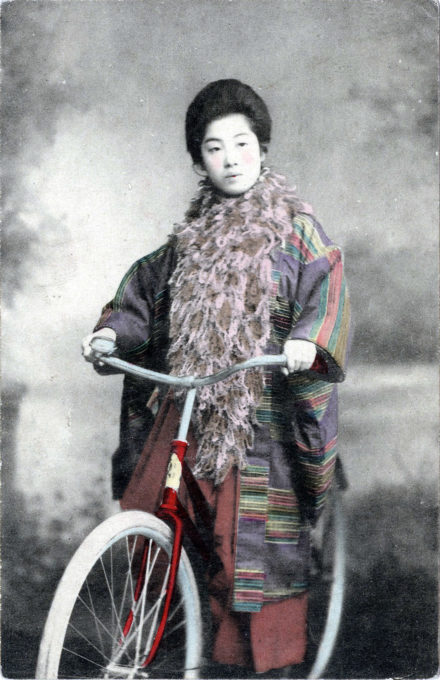See also:
Miyata Bicycle Co. New Year’s card, 1933.
Jinrikisha (Rickshaw) at Ueno Park, c. 1910.
“The bicycle made its way to Japan in the late 1860s, at the time of the Meiji Restoration, the political change that marked the beginning of Japan’s modern development.
“In these early years of the Meiji period, however, not all modes of transport were immediately accessible. Train transport was restricted to the rich and powerful. Bicycles were not only expensive, but socially impractical: in Japan, as in China, ‘gentlemen do not sweat’. Instead, Japan’s revolution in mobility was spearheaded by the rickshaw … The number of rickshaws in Japan reached a peak in 1896 with 210,000 countrywide, before gradually decreasing.
“The decline in rickshaw numbers coincided with the development of other forms of urban transport, including bicycles. In particular, the introduction of the more practical safety bicycle in 1889 and the application of mass-production technology in the early twentieth century gave birth to a bicycle boom akin to that experienced in Europe and the United States. The number of bicycles registered in Japan rose to around 10,000 by 1890 and continued to rise sharply. By 1901, there were 57,000 bicycles and by 1912 more than 400,000.
“By the early twentieth century, the bicycle was no longer merely a plaything of the wealthy and adventurous, but was championed for its utility as ‘the best means of transportation for the common person.’ The Asahi newspaper of August 21, 1902 described the streets of Tokyo as crowded with the daily traffic of over 20,000 government officials, office workers and delivery boys on bicycles, and declared that ‘the bicycle is no longer a luxury item.’ By 1927, with a population of just under 90 million, some 4.7 million bicycles were in use.
“Noting the rapid expansion in self-propulsion, the Minister of Commerce and Industry declared November 1, 1927 to be ‘Bicycle Commemoration Day’. Claiming that Japan had become the ‘foremost bicycle country in the world,’ the minister heaped praise on the ‘speedy footwear of the working class.’ He further noted its importance as an export item that generated more than 200 million yen
in revenue. Indeed, by the 1930s, Japan was the third largest producer of bicycles, following the United Kingdom and the United States.”– The Making of a Bicycle Nation: Japan, by M. William Steele, Transfers Vol. 2 Issue 2 (Summer 2012), 2012


